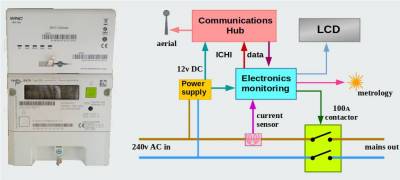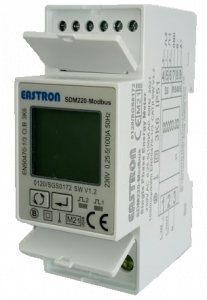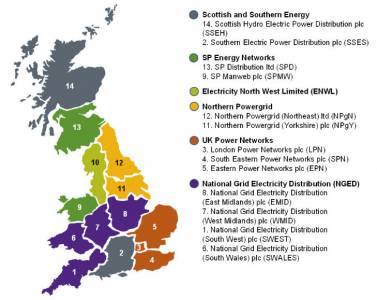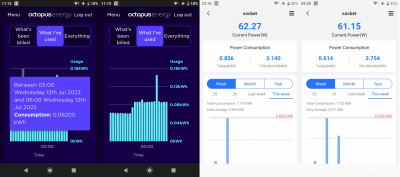How do smart meters actually measure the amount of energy?
I am curious about the actual means and method of measurement of energy passing through the smart meter; I’m actually curious as to how my exported energy is monitored (but suspect that import and export are similar in how they work). In all the articles I have looked up, I read that the system measures voltage and current flow ‘at regular intervals’ and that these figures are used to arrive at an amount for every 30 minute interval. I am interested to know how frequent these intervals are and how long a time period such samples are taken. It sounds to me as though there is plenty of room for error if intervals are less frequent or of too short a duration to arrive at an average figure. I am not complaining or doubting the readings used by my energy supplier as they seem higher than the readings I see from my Enphase and Tesla apps! Nevertheless I am curious to know how the measurements of the various meters is arrived at; as the DNO installed equipment is the most favourable (to me at least), I also hope it is the most accurate one! I feel sure that at least one forum reader is far more knowledgable than I in such matters and would be grateful for any enlightenment please! Regards, Toodles.
Toodles, heats his home with cold draughts and cooks food with magnets.
Smart meters must comply with a specification developed 2013-14 by the then Dept of Energy.
However, each manufacturer is free to decide the physical mechanism they use to measure voltage and current.
Their accuracy is defined by the Measuring Instruments Regulations (SI 2016/1153) which applies to all energy meters, not just the newer SMETS1 and SMETS2 styles.
The basic block diagram is this:
If you wished to check the accuracy of a meter, then you should install a secondary meter with MID certification.
These are readily available online (eg here from Amazon), most commonly made by Eastron or Acrel.
A meter with Modbus RS485 connections will allow you to interrogate it from your own computer and compare with the one owned by your Electricity Supplier.
BTW, your DNO does not own your Smart Meter.
Their responsibility ends at the (100A) Service Fuse.
Save energy... recycle electrons!
@transparent Thank you for that reply Transparent, I don’t think I’ll concern myself in buying a second consumption meter for verification purposes but just accept that the one meter is ‘the most accurate one’ in the system - especially as the readings my energy supplier used to pay me for my export are rather more generous than the other metering systems would suggest! Sorry about the confusion over the ‘ownership issue”, the original meter that was in the house when we moved in proved to be faulty and our then supplier (Southern Electricity) replaced it and we came to an amicable agreement about compensation for possible/likely overcharging that may have been involved. I assumed that Southern Electricity were the same as SSEN in later years - perhaps I’m confused here? BTW, I did query the difference in readings with my energy supplier a while ago and they assured me that after checking, the meter was performing normally so who am I to argue?! Regards, Toodles
Toodles, heats his home with cold draughts and cooks food with magnets.
Scottish Hydro-Electric merged with Southern Electricity in 1998 to form SSEN, which is one of six DNOs who hold licences to operate the 14 regional distribution grids.
Here's Ofgem's current map showing those geographical boundaries.
SSE Energy Services was part of the SSE PLC group, which had a licence to operate as a Domestic Energy Supplier.
They operated nationally, not just within the DNO Region for which their parent company held the DNO licence.
OVO Energy Group bought SSE Energy Services from SSE PLC in 2020 when almost twenty UK-based Suppliers were facing financial problems.
SSE Energy Services had amassed a high proportion of sites with pre-payment meters, and those customers were most adversely affected by the energy crisis.
They also had wider experience than OVO in fitting a range of different designs of Smart Meter. But that expertise is expensive to maintain.
Save energy... recycle electrons!
@transparent Thank you Transparent, perhaps you may see why I was a little confused. Regards, Toodles.
Toodles, heats his home with cold draughts and cooks food with magnets.
Posted by: @toodlesI am curious about the actual means and method of measurement of energy passing through the smart meter; I’m actually curious as to how my exported energy is monitored (but suspect that import and export are similar in how they work). In all the articles I have looked up, I read that the system measures voltage and current flow ‘at regular intervals’ and that these figures are used to arrive at an amount for every 30 minute interval. I am interested to know how frequent these intervals are and how long a time period such samples are taken. It sounds to me as though there is plenty of room for error if intervals are less frequent or of too short a duration to arrive at an average figure. I am not complaining or doubting the readings used by my energy supplier as they seem higher than the readings I see from my Enphase and Tesla apps! Nevertheless I am curious to know how the measurements of the various meters is arrived at; as the DNO installed equipment is the most favourable (to me at least), I also hope it is the most accurate one! I feel sure that at least one forum reader is far more knowledgable than I in such matters and would be grateful for any enlightenment please! Regards, Toodles.
In the most basic terms a mains power meter measures both the AC voltage and the AC current and multiplies them together to calculate the Power, which is displayed as kWh.
This is not actually correct, since the derived value is Volt-Amperes per hour, but kWh are used probably because most people are more familiar with this term, or it could be the fact that in the very early days of development, electrical systems were DC, for which kWh would be the correct term.
In most cases in the UK, electricity is supplied to homes as single phase at approximately 240 volts. This is the Root - Mean - Square (RMS) value, which would equate to the required DC voltage to provide the same quantity of power. The sinusoidal waveform actually goes from zero volts, to a positive peak of approximately +340 volts, back through zero volts, to a negative peak of approximately -340 volts, then back to zero volts again. It carries out this cycle 50 times each second. The AC current flow also increases and decreases, both positively and negatively with the voltage, though not necessarily in phase.
Without opening up a mains power meter to see what is actually inside, I can only make assumptions as to how the internals work.
For voltage measurement it could be that the mains supply is initially passed through a bridge rectifier, so that both positive and negative peaks are in the same direction, then through a resistance divider to lower the voltage to a more acceptable level for electronic circuitry. It could be that the value of each peak is then measured and the RMS voltage calculated. Alternatively rectification and smoothing could be performed on the incoming AC voltage, with the resultant DC signal being proportional to the actual RMS value.
Passing the AC current through a low value resistive shunt would produce a voltage signal proportional to the current flowing. This would also then be processed in a similar manner to the AC voltage.
After suitable analog to digital conversion, these two signal would be multiplied together to produce the resultant power level.
If the frequency of measurement is at each peak, both positive and negative, that would provide 100 samples each second, which could then be summed over an appropriate time period and the actual quantity of power calculated. This value would then be added to the running total of power consumed.
To monitor export for billing purposes may require a more specialised power meter.
The above is my thoughts on how a mains power meter may operate, but of course I could be wrong.
Posted by: @toodlesI am curious about the actual means and method of measurement of energy passing through the smart meter; I’m actually curious as to how my exported energy is monitored (but suspect that import and export are similar in how they work). In all the articles I have looked up, I read that the system measures voltage and current flow ‘at regular intervals’ and that these figures are used to arrive at an amount for every 30 minute interval. I am interested to know how frequent these intervals are and how long a time period such samples are taken. It sounds to me as though there is plenty of room for error if intervals are less frequent or of too short a duration to arrive at an average figure. I am not complaining or doubting the readings used by my energy supplier as they seem higher than the readings I see from my Enphase and Tesla apps! Nevertheless I am curious to know how the measurements of the various meters is arrived at; as the DNO installed equipment is the most favourable (to me at least), I also hope it is the most accurate one! I feel sure that at least one forum reader is far more knowledgable than I in such matters and would be grateful for any enlightenment please! Regards, Toodles.
I think your question stems from the semantics used in some articles where they use interchangeable the action of the meter constantly measuring the voltage and the current passing through the meter with the action of the meter displaying and/or transmitting the "interval" calculated total energy used(half hour) etc.
@fazel I suppose that the method of measurement must vary between types / manufacturers of measuring instrument as the Tesla and Enphase are close in their readings but the metering system on the grid input wiring tells a rather different story (favourable to me - but then, the consumption might also be equally ‘different’ to the others!) Who guards the guards? Regards, Toodles
Toodles, heats his home with cold draughts and cooks food with magnets.
Addendum: The MyEnergi Eddi concurs broadly with the Tesla and Enphase reports too. Regards, Toodles.
Toodles, heats his home with cold draughts and cooks food with magnets.
Posted by: @toodlesWho guards the guards?
We do! ... here on the RHH forum!
In a democracy we have the opportunity to challenge the strategy, regulations and design of our energy system!
Just yesterday I wrote to a Parliamentary Under-Secretary of State to highlight a conflict between an energy regulation (passed by Parliament) and the way in which Smart Meters operate.
And today an elected member of my Local Planning Authority will be challenging his own Council on why it issues documents stating that heat pump installations comply with Part-L of the Building Regulations when there's no evidence that they do.
Both of these are issues which are being discussed on this Forum.
Here we are able to discuss a subject, revise our opinion in response to feedback from others, and gather relevant 'evidence'.
In some respects we actually have a responsibility to provide this information to those who write our regulations, but too few of us do.
For example, the newly-formed Parliamentary Committee on Energy Security and Net Zero is currently asking us for evidence on five subjects which they are investigating
I suggest that the responses any of us give would benefit from first being aired here on the Forum.
Not only does that enable the argument to be 'knocked into shape' but you can also give the URL of the Topic so that the sources of your evidence can be validated.
That carries more weight.
Save energy... recycle electrons!
@toodles After years of not wanting a smart meter(I live in a rental), I moved this month to Octopus tracker to see how it goes for a year to see if it's worth it.
In trying to see what my base load is, this is a comparison between what I can see displayed on my account the day after vs what an amazon/China plug power meter socket registers of my fridge when everything else is off.
62.something rounded to 63, 61.something rounded to 62. I'm yet to read the actual meter for a longer period to compare the total displayed, as it's high on the wall, etc.
The explanation above is partly correct - If the meter multiples the RMS voltage times the RMS current, it calculates volt-amperes, usually referred to as kVA (for 1000 VA). But domestic consumers pay for kW, not kVA, (actually kWh). For an AC signal, if the current is exactly in phase with the current (a resistive load such as a room heater without a fan or other refinements) kW = KVA. The meter calculates kW by multiplying the voltage at one instant by the current at that same instant, and it does this many times per mains cycle, and averages the readings. How many times per cycle? Depends on the meter. For some electronic loads (eg a PC switching power supply) the current may be very far from a sine wave, and the faster the meter "samples" the voltage and current, the better measurement it can make of distorted waveforms. The standards behind the measurement instrumentation directive (MID) specify how much distortion and how accurately the meter must report the true power (by comparison with a reference wattmeter). Any meter that is used for revenue purposes (ie your electricity bill) must meet a defined standard to make sure you are billed accurately. The other equipment that you have that measures kWh is intended for helpful guidance, not billing, and the accuracy standard it reaches is at the manufacturer's discretion. So they should roughly track the utility revenue meter, but may be a bit off, especially if the environment is particularly hot or cold. The revenue meter must maintain it's accuracy over the full range of expected temperatures.
A smart meter has an internal clock and averages the kWh over each half hour, so if you consume a steady 1kW, it will report half a kWh in each half hour. These have been used for industrial consumers for decades - the consumer mostly gets a cheaper price, but when electricity is in high demand the price rockets, and industrial consumers switch off, avoiding most of the high cost electricity and also reducing demand on the supply system
Because of the way they work, electronic electricity meters have a lot of information about the voltage and current, and can also easily calculate RMS voltage, RMS current, kVA and other parameters (power factor, kvar, maximum demand etc) but that's a longer story, that mostly only affects very large electricity consumers and producers.
- 26 Forums
- 2,396 Topics
- 54.3 K Posts
- 163 Online
- 6,077 Members
Join Us!
Worth Watching
Latest Posts
-
RE: Recommended home battery inverters + regulatory matters - help requested
The diagram below is a simplified view of the internals...
By Batpred , 1 hour ago
-
RE: Heat pump not reaching flow temperature
@davec Ive had a look at the screenshots. Lots of th...
By JamesPa , 1 hour ago
-
RE: Vaillant aroTherm not heating with many faults
When I had a series of apparently unrelated faults my i...
By JamesPa , 2 hours ago
-
RE: Considering MLCP (Multi-Layer Composite Pipe) for ASHP
OK, TBH I dont know enough about MLCP to comment with a...
By JamesPa , 4 hours ago
-
RE: Predicted Heat Loss from MCS calcs vs EPC vs actual
My gut feeling is that the heat pump is right sized. ...
By Tim441 , 5 hours ago
-

RE: Power outages and storms: A surprisingly good DNO experience
Agreed, which is no more nor less than a customer shoul...
By Majordennisbloodnok , 6 hours ago
-

RE: Running from backup generaor in powercut?
@batpred In our case, 3 times each day when the Octopus...
By Toodles , 7 hours ago
-
RE: Advice for a novice on Mitsubishi Ecodan 6kW
Hi @sheriff-fatman Cycling at 5C and below is usuall...
By RobS , 7 hours ago
-
RE: New Fogstar 15.5kWh upright solution
@batpred Here's the latest Fogstar ready built pack....
By Bash , 9 hours ago
-
RE: RDSAP10 effect on existing heat pump EPC rating?
@mike-patrick yes, even though the current system is ru...
By Tim441 , 9 hours ago
-
RE: Solis inverters S6-EH1P: pros and cons and battery options
Solis confirmed that the S6 works with a single battery...
By Batpred , 9 hours ago
-
RE: Who has a V2G EV installation
I am wondering if in any V2X, would the car battery eve...
By Batpred , 10 hours ago
-

RE: Setback savings - fact or fiction?
Yes, by calculating it manually from the minute data, w...
By cathodeRay , 11 hours ago
-
Fan unit Making terrible noise HELP!!
One of a pair of fan units on an Earth Save Classic II ...
By GutoFfowc , 12 hours ago
-
RE: New Mitsubishi Ecodan 11.2kW installation - L9 errors and maybe more
OK. I think your system, which seems well designed, is...
By JamesPa , 13 hours ago
-

RE: Heatpunk Floor plan issues
It's usually the complete opposite... seldom that Safar...
By Mars , 1 day ago
-

RE: Fan is clipping ice build up from the front of unit.
@majordennisbloodnok I’ll not go there thanks! Toodles.
By Toodles , 1 day ago
-
RE: Running my new Nibe ASHP efficiently
I'm new to the forum. Did you get a reply to this last ...
By Mike @ Camelot , 1 day ago
-

RE: ASHP Energy Consumption: Aira 12kW heat pump
@grantmethestrength MCS requirements for DHW capacity h...
By Toodles , 1 day ago










